Discovering the Beauty of French Provincial Cabinets
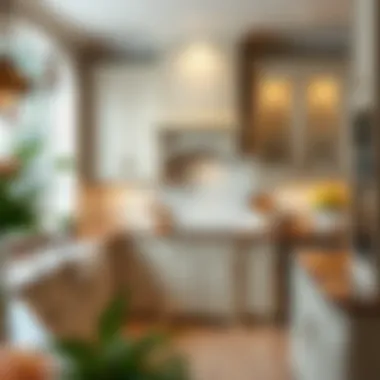
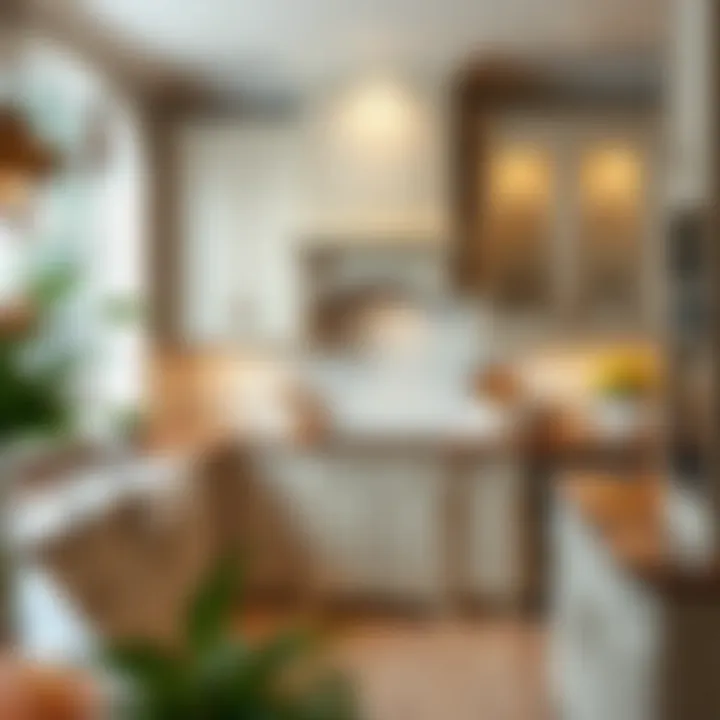
Intro
The allure of French Provincial kitchen cabinets lies not just in their aesthetic appeal, but in their ability to weave together history and functionality. Commonly known for their rustic charm, these cabinets create a warm ambiance that can transform any kitchen into a haven of elegance. As homeowners increasingly pursue designs that merge sophistication with a cozy atmosphere, getting acquainted with the nuances of French Provincial styles is essential.
In this article, we will explore several facets of French Provincial kitchen cabinets—from the inspiration behind their design to practical maintenance tips. Knowing the fine points will empower you, whether you’re a seasoned homeowner or just someone eager to create an inviting space.
Design Inspiration
Design is often about reflecting one’s personal aesthetic while also considering the environment it exists in. French Provincial kitchen cabinets provide a delightful blend of rustic and refined. Their origins trace back to the countryside of France, where practicality met romance. This nostalgic style gives kitchens a timeless grace reminiscent of pastoral life alongside a fresh take for contemporary kitchens.
Trending Styles and Themes
When discussing styles, various trends within the French Provincial theme emerge:
- Shaker Style: This minimalist approach emphasizes function over form, characterized by clean lines and simplicity. Perfect for modern settings, yet holds onto traditional touches.
- Distressed Finishes: This intentional wear-and-tear look transports homeowners to bygone eras. It adds a layer of character and charm that brand-new cabinets might lack.
- Open Shelving: Combining both decor and utility, open shelving within cabinets allows for decorative displays while keeping essential items accessible.
By merging these styles with contemporary sensibilities, French Provincial cabinets can inject life into a kitchen, leading to a space that bears both elegance and an air of casual comfort.
Color Palettes and Combinations
Color plays an instrumental role in breathing life into space. A typical color palette for French Provincial cabinets leans heavily into soft, muted tones.
- Cream and Off-White: These hues are foundational in creating a light and airy atmosphere that amplifies the size of a space.
- Soft Blues and Greens: Evoking the beauty of the French countryside, these colors can add a subtle pop that remains understated and elegant.
- Rich Earth Tones: Shades of terracotta or taupe can introduce warmth while keeping to the rustic theme.
Combining these colors with natural wood accents or antique hardware can evoke a sense of timeless charm, ensuring the kitchen remains inviting and warm.
"In design, every detail matters; it's the sum of these details that creates an atmosphere."
Through understanding the design elements—both stylistic choices and color combinations—you’re well on your way to infusing your kitchen with the French Provincial charm. As we dive deeper into the practical aspects, we will cover materials used, maintenance, and how to seamlessly integrate these cabinets into your existing space.
Historical Background of French Provincial Style
The French Provincial style represents a harmonious blend of elegance and comfort, emerging primarily from the rural regions of France during the late 17th and early 18th centuries. Understanding this historical background is vital for anyone seeking to incorporate French Provincial kitchen cabinets into their homes. This style encapsulates a rich narrative, illustrating how local craftsmanship and lifestyle influenced its design elements and functionality.
Origins and Evolution
Initially, the French Provincial style emerged as a reflection of the aristocracy moving away from the urban centers, searching for serenity in the countryside. This shift spurred a unique fusion of styles, linking rustic charm with noble refinement. Everything from the simple lines of furniture to the practicality of cabinetry was forged from the daily lives of those living in provincial towns. It was a response to the grandiosity of the royal court styles, which often emphasized opulence over utility.
The cabinets designed in this period showcased simple forms but were imbued with an understated elegance. They evolved to include a variety of materials, predominantly from local sources, which contributed to both their aesthetic appeal and durability.
This style has continued to evolve, barely keeping pace with changing ergonomic preferences in contemporary kitchens. Nevertheless, those basic characteristics—possessing a rustic quality while designed to be functional—remain at its core. Integrating these historical elements into modern kitchen design creates a nuanced space that resonates with the essence of French tradition.
Influence of Rural French Life
Rural French life has played a crucial role in shaping the distinct characteristics of French Provincial cabinets. Life in the provinces was, and still is, governed by simplicity and functionality, adhering to what can be described as a "less is more" philosophy.
French farmers and artisans crafted their own cabinets from readily available materials, which means wood choices were often dictated by the trees that surrounded them. For instance, oak was commonly used due to its abundance and resilience. Each piece reflects the craftsmanship and lifestyle of the era; the detail in carvings, the soft curves, and even the choice of colors all tell stories of the environment and culture.
Moreover, the warm hues and soft finishes found in these cabinets draw inspiration from the earthy tones of the rural landscape. These elements foster an inviting atmosphere, making French Provincial kitchens a welcoming space for family gatherings and shared meals.
In modern interior design, capturing the essence of rural life through French Provincial cabinetry is more than just an aesthetic choice. It demonstrates an appreciation for artistry and history while embracing the utility necessary for today’s bustling households.
"The French Provincial style is not merely a design trend, but a testament to the stories forged in rustic kitchens around wooden tables, where culinary traditions were born."
By understanding the historical context and influences of French Provincial style, homeowners and design enthusiasts can better appreciate why these cabinets remain a popular choice. Their roots encapsulate the marriage of rustic sensibility and refined elegance, making them an ideal feature for those looking to add warmth and character to their kitchens.
Key Features of French Provincial Kitchen Cabinets
When delving into the realm of French Provincial kitchen cabinets, one cannot overlook their distinctive features that encapsulate both elegance and rustic charm. This style is celebrated for its ability to meld traditional aesthetics with functionality, creating an inviting atmosphere within the heart of the home. Understanding these key traits not only enhances the appreciation for the craftsmanship involved but also aids homeowners in making informed choices when it comes to such cabinetry.
Distinctive Design Elements
Distinctive design elements play a critical role in defining the French Provincial aesthetic, each contributing to the overall ambiance and functionality of the kitchen.
Crown Moldings
Crown moldings are often seen as the icing on the cake in French Provincial cabinets. These intricate details generally finish off cabinetry with elegance, connecting the cabinets to the ceiling seamlessly. The characteristic feature of crown moldings in this style is their graceful curves, which add a touch of sophistication to the overall design. Crown moldings aren’t just decorative; they also serve to provide a visual extension of the cabinetry, enhancing the feeling of height and space in the kitchen. While they require precision during installation, getting the right angle or joint, their presence truly elevates the kitchen’s aesthetic appeal.
Intricate Hardware
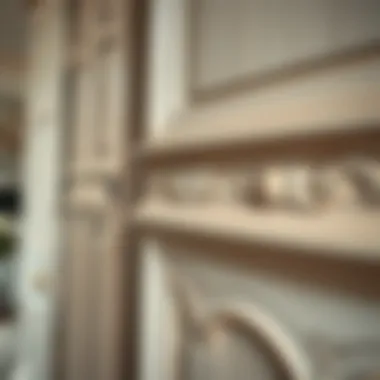
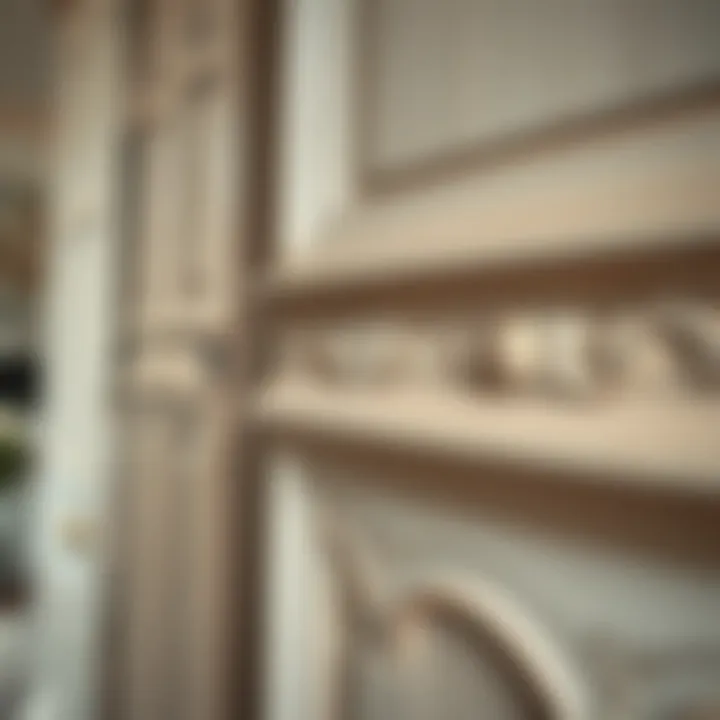
Intricate hardware, including knobs and handles, is another notable feature that spotlights the artistry involved in French Provincial design. These pieces often showcase ornate designs, perhaps floral patterns or scrollwork, embodying the craftsmanship of the era. The key characteristic of this hardware is its ability to enhance the overall appearance of cabinets without overwhelming them. Opting for such hardware can transform simple cabinets into statement pieces, creating points of interest throughout the kitchen. However, care must be taken to ensure that the hardware chosen is in harmony with the cabinet style itself, as mismatched designs could detract from the cohesive look.
Soft Curves and Flourishes
The soft curves and flourishes of French Provincial kitchen cabinets embody a certain gentleness often absent in modern designs. This element contributes significantly to a warm, welcoming atmosphere. These curves frequently appear in the cabinet doors and edges, providing an organic feel which contrasts beautifully with sharper, more contemporary lines. The advantage of this feature is its ability to soften the overall appearance, making the kitchen feel less structured and more inviting. However, one must also consider maintenance; intricate curves can gather dust or grime more easily than flat surfaces, requiring a bit of extra TLC to keep them looking pristine.
Color Palette and Finish Options
Color choices and finishes further accentuate the beauty of French Provincial cabinets, grounding the design in both tradition and warmth.
Traditional Whites and Creams
Traditional whites and creams are staples in French Provincial kitchen design. These hues embody purity and simplicity, often acting as a backdrop that allows intricate details to shine through. The key characteristic of these colors is their versatility; they pair well with various accents and textures, making them suitable for any style preference. The use of airy whites can also make a small kitchen appear larger and brighter, thus enhancing the space. However, they require more consistent upkeep, as they can show wear or stains readily.
Earthy Tones
Earthy tones, including soft taupes and warm browns, bring an organic feel to the kitchen, embedding it in nature's palette. The unique feature of this color group is its ability to evoke a sense of grounding and tranquility, fostering a cozy ambiance. These tones effortlessly blend with wooden elements, further tying the kitchen's look together. A disadvantage, however, can be their tendency to darken a space, which may not be suitable for kitchens with limited natural light.
Antique Finishes
Antique finishes add a layer of depth and history to cabinets, enhancing the rustic charm of the French Provincial look. The key characteristic of these finishes is their crafted appearance, often creating a worn effect that invites touch and evokes nostalgia. An antique finish can disguise minor blemishes and scratches, providing an aged, yet refined aesthetic. On the flip side, these finishes may require specific care to maintain, and not all homeowners might appreciate the less uniform appearance that comes with heavily distressed cabinetry.
Incorporating these key features into kitchen design can create a harmonious blend of functionality and visual appeal, vital for any homeowner aiming to recreate the grace of a French Provincial style.
Types of French Provincial Kitchen Cabinets
When discussing French Provincial kitchen cabinets, one cannot overlook the variety of styles available. Each offers its own flair while still embodying the elegant yet rustic charm inherent in this classic design aesthetic. Understanding the intricacies of various cabinet types can help homeowners and designers alike make informed choices that suit their personal tastes and functional needs.
Shaker Style Cabinets
Shaker style cabinets represent a harmonious blend of form and function that resonates well with the French Provincial ethos. These cabinets are characterized by their simple, clean lines and minimalist look. Traditionally built from solid woods, such as poplar or maple, they bring warmth and character to the kitchen. The absence of excessive ornamentation allows the natural beauty of the wood to shine through, making it an excellent choice for homeowners seeking to emphasize authenticity.
A notable trait of Shaker cabinets is the recessed panel design. This feature not only enhances visual appeal but also makes them easier to clean—an essential aspect for a busy kitchen. Homeowners love that they can choose from a variety of finishes, ranging from a rustic distressed look to a more refined paint that complements their overall kitchen aesthetic.
Moreover, these cabinets often flaunt solid and functional hardware like brushed brass or matte black knobs, which balance neatly with the wood. This style often pairs seamlessly with both modern and traditional kitchen designs, providing flexibility in harmonizing different elements.
Armoire Style Cabinets
Armoire style cabinets provide a show-stopping focal point in any kitchen, capturing the essence of French provincial charm. These cabinets are typically larger and designed to store a multitude of kitchen items, from dishes to appliances. Their tall stature and ornate embellishments often include curved edges, decorative moldings, and glass doors, which can create an illusion of spaciousness while adding visual intrigue.
The beauty of the armoire style lies in its multifaceted functionality. They can serve as excellent storage units while also acting as display cases for fine china or decorative pieces. This style often comes in rich finishes such as deep mahogany or antique whites, providing both warmth and sophistication.
Elegantly crafted with a nod to traditional French craftsmanship, armoire style cabinets can enhance a kitchen's character, making it both practical and inviting. They breathe life into a space, offering a glimpse into the rustic French countryside without sacrificing functionality.
Glass-Front Cabinetry
Glass-front cabinetry holds a unique place in the hierarchy of French Provincial kitchen designs. A hallmark of elegance, these cabinets combine functionality with aesthetic appeal by allowing the contents to be viewed without unveiling everything on display. This style invites a personal touch, as homeowners can showcase their favorite dishware or decorative items while keeping the less visually appealing items concealed behind closed doors.
Typically framed in wood, glass-front cabinets can have multiple design variations—from traditional mullioned frames to modern sleek designs that echo contemporary styles. This versatile feature enables homeowners to adapt the cabinetry to fit various tastes, whether one leans towards rustic charm or modern elegance.
Moreover, incorporating glass inserts can make a kitchen feel lighter and more spacious, giving it an airy feel. As kitchens become increasingly vital gathering spaces in the home, showcasing cherished items through glass-front cabinets can add a heartfelt, personalized touch to the overall kitchen design.
Ultimately, French Provincial kitchen cabinets—be they Shaker, Armoire, or Glass-Front styles—not only convey elegance but also reflect the homeowner's personality and practical needs, creating a truly inviting atmosphere.
Materials Used in French Provincial Cabinets
When discussing French Provincial kitchen cabinets, the materials chosen hold significant weight in defining the style, durability, and aesthetic appeal. Not only do they contribute to the visual aspect of the cabinets, but they also have practical implications regarding longevity and maintenance. Selecting the right materials can make or break the overall look and functionality of your kitchen. Many homeowners gravitate towards natural materials that embody a rustic charm while also ensuring that the cabinetry resists wear over time. Each wood type or additional elements utilized brings something unique to the table, ultimately shaping the kitchen's character.
Wood Choices
Oak
Oak is among the most favored woods in French Provincial cabinetry. This robust wood stands out due to its remarkable strength and durability, making it a popular option for those looking for longevity in their kitchen fixtures. One key characteristic of oak is its distinct grain patterns, which add an element of natural beauty. Its natural light color can be easily stained to suit various design palettes, making it versatile.
The unique feature of oak is its ability to withstand physical impacts, which translates to furniture that can endure the rigors of a bustling kitchen. However, its dense nature can sometimes make it heavier than other options, potentially complicating installation. In the grand scheme of French Provincial designs, oak lends itself well to those in search of a solid and reliable choice.
Cherry
Cherry wood is another excellent choice for French Provincial kitchens, known for its rich color and smooth texture. One of its most notable features is the way it deepens in hue over time, transitioning to a beautiful reddish-brown that many find desirable. This gives cherry a sense of history and warmth, adding depth to the ambiance of the kitchen.
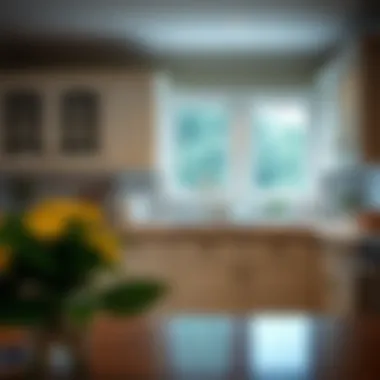
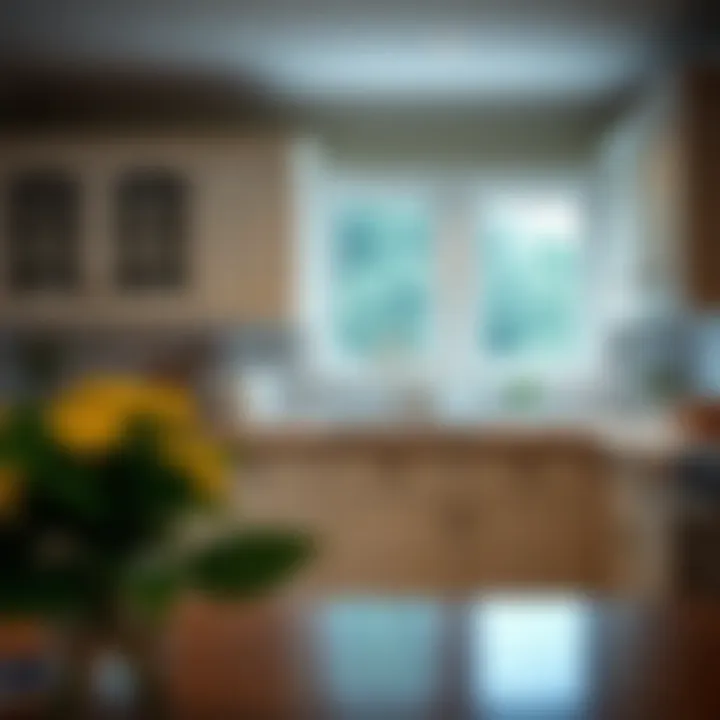
The advantage of using cherry is its ability to hold intricate carvings and detailing, aligning perfectly with traditional French craftsmanship. However, cherry can be somewhat sensitive to extreme humidity and temperature changes, which may complicate its maintenance in certain environments. Still, its visual appeal and adaptability make it a favored material among those who appreciate its understated elegance.
Walnut
Lastly, walnut offers a striking alternative to oak and cherry. Its dark, luxurious appearance is paired with a finely patterned grain, making walnut stand out in any kitchen. This wood is often admired for its softness and workability, which allows for clean lines and intricate designs that reflect the opulence of French Provincial style.
The key feature of walnut is its resistance to warping and its longevity. While it tends to be more expensive compared to other wood types, its stunning appearance often justifies the cost for many homeowners. Conversely, walnut does require more careful cleaning to maintain its luster, as certain harsh chemicals can mar its finish. Nonetheless, incorporating walnut into French Provincial cabinets can elevate the space into something truly refined.
Incorporating Other Materials
While wood plays a significant role in the overall aesthetic of French Provincial cabinets, many designs incorporate additional materials to enhance their appeal and function.
Metal Accents
Metal accents can transform standard cabinets into eye-catching centers of the kitchen. These accents often come in the form of decorative hardware such as hinges, knobs, and handles. One of the standout features of metal accents is their durability and resistance to wear, which is essential in high-use areas like kitchens.
Incorporating metals like brass or wrought iron offers a contrasting texture that can beautifully complement the warmth of wood. They also allow for a subtle infusion of modernity into a traditionally rustic design, making them a popular addition. However, overdoing metal accents can lead to a cluttered look, so moderation is key.
Glass Inserts
Another popular feature often seen in French Provincial cabinetry is glass inserts. These can be utilized in upper cabinets, offering a glimpse into the contents while providing a sophisticated touch. The clear transparency of glass creates an illusion of openness, making even smaller kitchens appear more spacious.
The benefit of glass inserts is that they can be styled in numerous ways, such as frosted or textured options that enhance privacy and uniqueness. However, home chefs might want to consider the maintenance aspect of glass, as it can become smudged or dirty more easily compared to wood surfaces. Overall, glass adds an element of elegance, balancing functionality with aesthetic appeal in French Provincial kitchens.
Designing with French Provincial Cabinets
In the realm of kitchen interiors, the design of furniture can make or break the overall aesthetic. Designing with French Provincial cabinets speaks not just to the look but the essence of a home, weaving together history, culture, and functionality. These cabinets encapsulate a narrative that merges elegance with a cozy, rustic flair, capturing the spirit of French rural life.
The role of these cabinets extends beyond mere storage; they embody a philosophy that values craftsmanship and warmth. When integrating French Provincial cabinets into a kitchen, one must consider how each element interacts to create a harmonious space. It's about creating a backdrop that allows for memory-making, cooking, and gathering.
Creating a Cohesive Kitchen Design
A cohesive kitchen design that incorporates French Provincial cabinets can be a delightful exploration of textures, colors, and forms. When selecting these cabinets, think about how their traditional features can complement modern appliances or décor styles.
The elegant lines of French Provincial cabinets often beg for a welcoming environment, suggesting earthy tones or light pastels for wall colors. A well-thought-out color palette enhances the warm, inviting nature of the cabinets themselves, fostering a seamless blend with the kitchen's overall design.
- Soft Neutrals: Paint the walls in soft whites or creams, reflecting the airy feel often found in traditional French kitchens.
- Contrasting Accents: Use darker woods or vibrant splashes of color in tile backsplashes to highlight the beauty of the cabinets.
- Lighting Considerations: Task and ambient lighting should work together. Consider pendant lights or under-cabinet lighting to accentuate the details of your French Provincial cabinetry.
Blending Styles
When designing with French Provincial cabinets, blending styles could be a creative way to incorporate your unique personality into your kitchen. Merging various styles leads to innovation and a space that feels like home.
Modern Touches
Modern touches serve as a bridge between the old and the new, creating a dynamic space without losing the essence of French Provincial charm. A key characteristic of modern design is minimalism, often incorporating sleek lines and uncluttered aesthetics that stand in pleasant contrast to the traditional curves of these cabinets. This contrast can add depth and character to the kitchen, making it feel not just stylish, but relevant to today’s lifestyle.
For example, using contemporary metal hardware instead of the intricate wrought iron typically found in Provincial design offers a fresh perspective. However, while these modern elements can elevate the kitchen’s style, there’s a risk that they may overshadow the traditional appeal of the cabinets, which is why balance is key. A touch here and a contrast there can produce a timeless look that feels both new and nostalgic.
Rustic Elements
Rustic elements serve to enhance the cozy, inviting nature of French Provincial kitchen cabinets, celebrating the natural beauty of materials. The essence of rustic design lies in its raw, unpretentious details, which often include rough-hewn wood and artisanal finishes. The key characteristic of rustic elements is that they tell stories—of craftsmanship and of the hands that shaped them.
Incorporating elements like reclaimed wood shelves or vintage-style open cabinetry creates a dialogue with the French cabinets. This approach not only reinforces the nostalgic charm but also adds layers of texture to the kitchen. However, be cautioned that an overabundance of rustic features can result in a cluttered appearance; the idea is to create a balance that still allows the elegance of the cabinets to shine.
Through a thoughtful approach to these contrasts, Designing with French Provincial cabinets becomes an art form, inviting creativity while ensuring practical utility. The end result is a kitchen that not only serves purposes of cooking and eating but also stands as a testament to good design, imbued with personal flair.
Functional Aspects of French Provincial Cabinets
French Provincial kitchen cabinets hold a special place in the hearts of many homeowners due to their unique blend of form and function. While their aesthetic appeal often captures attention, it's crucial to recognize that the real charm lies in their utility. These cabinets are designed not just to impress but to enhance day-to-day activities in the kitchen.
One of the primary aspects to consider is how effectively these cabinets can tackle common challenges in kitchen organization. Storage is a significant concern for many homeowners, and this is where French Provincial cabinets shine. Their thoughtful design and varying styles cater to a variety of organizational needs, making them an excellent choice for those who prioritize functionality without sacrificing beauty.
Moreover, accessibility is another pivotal element that stands out when examining these cabinets. A well-designed kitchen must ensure ease of access to all essentials, and the layout of French Provincial cabinets does just that. By allowing for intuitive access to pots, pans, and pantry items, these cabinets facilitate smooth workflow in the kitchen. This dual focus on aesthetics and practical use emphasizes why French Provincial kitchen cabinets are such an enduring choice.
In summary, the functionality of French Provincial cabinets is far from negligible. It's interwoven with their historical charm, creating spaces that are not only visually stunning but also practical for daily living.
Storage Solutions
When one thinks about kitchen cabinets, storage options are usually at the forefront of consideration. French Provincial cabinets provide an impressive variety of storage solutions that meet many different needs. These cabinets often come with deep drawers, multi-tiered shelving, and specialized compartments that allow for efficient organization.
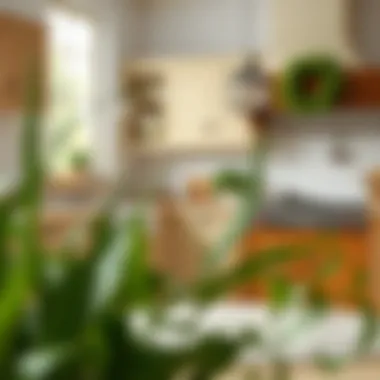
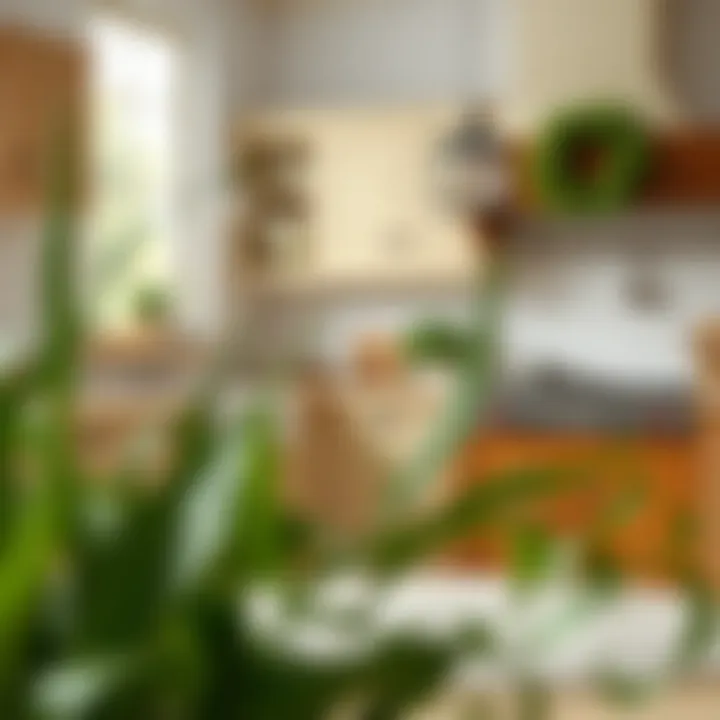
- Deep Drawers: Perfect for storing heavy pots and pans, reducing clutter on countertops.
- Vertical Cabinets: Great for taller items like baking sheets or mixing bowls.
- Pull-Out Spice Racks: These help maximize space while keeping spices easily accessible.
- Lazy Susans: Perfect for corner cabinets, allowing easy access to essential pantry items without the hassle of reaching into dark corners.
The design of these cabinets not only ensures you have plenty of places to store your kitchenware but also promotes an organized environment where everything is within reach. Beyond just aesthetics, this practical approach makes the kitchen a functional heart of the home.
Accessibility in Design
Accessibility is a key element often overlooked in kitchen design, yet it’s vital for creating a user-friendly cooking space. French Provincial kitchen cabinets are intentionally designed to be accessible, ensuring that both functionality and convenience are prioritized.
The layout of cabinetry is structured to provide a seamless workflow. Countertop heights and cabinet spacing can significantly impact how easily one can move about and use the kitchen. Some of the aspects that enhance accessibility include:
- Strategic Placement: Items you use most frequently should be placed at arm's reach, while less-used items can be stored higher or in the back.
- Easy-Open Hardware: Incorporating hardware that allows for smooth opening enhances ease of use, especially when hands are full.
- Ergonomic Considerations: Customizing cabinet heights can help accommodate different users, making the kitchen usable for everyone, from kids to taller adults.
An effectively designed kitchen fosters not just beauty, but functionality as well. The French Provincial style excels in this regard, facilitating both beauty and ease of use.
Maintaining French Provincial Kitchen Cabinets
Maintaining your French Provincial kitchen cabinets is essential not just for the sake of aesthetics but also for preserving their functionality and longevity. While these cabinets resonate with historic charm and elegant design, they can also be quite susceptible to wear and tear over time. Regular maintenance can prevent minor issues from escalating into significant headaches down the line.
Proper care ensures that you enjoy your investment for years without dealing with unsightly blemishes or structural issues. There are specific cleaning techniques to follow, as well as methods for restoration and repair that can help you keep your cabinets in tip-top shape.
Cleaning Techniques
When it comes to cleaning your French Provincial cabinets, it’s important to approach the task with the right methods and materials. Here are some effective techniques to consider:
- Gentle Cleaners: Use a mixture of warm water and a few drops of mild dish soap. Avoid harsh chemicals that can strip the finish or damage the wood.
- Soft Cloths: Always utilize soft, lint-free cloths to prevent scratching the surface. Microfiber cloths are a good choice here.
- Spot Cleaning: For tough spots or stains, dampen a cloth with your cleaning solution and gently rub the area in a circular motion, avoiding excessive force to prevent any possible damage.
- Dry Thoroughly: After cleaning, it’s crucial to dry the cabinets right away. Moisture can lead to warping or mildew formation.
Implementing these techniques regularly not only keeps the cabinets looking lovely but also helps maintain the wood's integrity, ensuring the natural beauty of the French design shines through.
Restoration and Repair
Despite your best efforts, French Provincial cabinets may require occasional restoration or repair to keep them in good shape. Here are some aspects to consider:
- Assessing Damage: Regularly inspect your cabinets for scratches, chips, or signs of wear. Noticing these issues early will help prevent more significant problems down the line.
- Refinishing: If your cabinets' finish is looking dull or worn out, consider refinishing them. This process involves sanding down the surface and applying a fresh coat of polyurethane or varnish to replenish their luster.
- Replacing Hardware: Over time, hardware such as knobs and hinges may become tarnished or broken. Consider upgrading to new hardware that complements the cabinet design while enhancing functionality.
- Professional Help: For extensive damage, such as warped doors or deep scratches, it may be worthwhile to consult a professional. They have specialized tools and expertise to restore your cabinets effectively without compromising their integrity.
Regular maintenance, combined with timely restoration and repair, can significantly extend the life of your French Provincial kitchen cabinets, keeping them an enduring centerpiece of your home.
By integrating these practices into your routine, you not only preserve the elegant characteristics of your French Provincial kitchen cabinets but also contribute to a lasting impression of quality and care in your home.
Cost Considerations and Budgeting
Budgeting is a vital component in any renovation or kitchen design project, especially when considering French Provincial kitchen cabinets. These cabinets encapsulate a unique blend of aesthetic charm and practicality. However, understanding the financial aspects can help homeowners make wise choices without breaking the bank. The right budgeting ensures that one can enjoy the style and functionality they desire, while still keeping costs at bay.
A few critical elements to consider include not only the upfront cost of cabinets but also how quality often correlates with longevity. When investing in these cabinets, it’s essential to weigh the initial material expenses against potential savings from durable construction that withstands regular use. Choosing higher-quality materials can minimize the need for repairs or replacements in the long run. This is effectively a case of “pay now or pay later.”
Additionally, things like installation costs can vary dramatically based on several factors, such as the complexity of the design, location, and whether you choose to hire professionals or embark on a DIY venture. Knowing these aspects of cost can help homeowners align their desires with financial capacity.
Evaluating Material Costs
When it comes to French Provincial kitchen cabinets, different materials can significantly affect the overall cost. The most common choices include oak, cherry, and walnut. Each of these woods boasts unique properties, aesthetics, and price points:
- Oak: Generally more affordable, oak is sturdy and offers an attractive grain pattern. Its affordability can be tempting for those on a tighter budget.
- Cherry: This wood is typically more expensive due to its refined appearance and durability. Cherry cabinets tend to deepen in color over time, adding character to your kitchen.
- Walnut: Known for its richness and complexity in color, walnut often falls on the higher end of the spectrum. The beautiful grain can justify the expense for many homeowners looking for something special.
Beyond wood choices, the finish also plays a pivotal role in the overall material cost. Custom finishes can push prices up but also enhance the beauty and functionality of the cabinets. Prospective buyers should carefully consider whether a bespoke finish is necessary for their vision or if standard options will suffice.
Installation Expenses
The installation of French Provincial kitchen cabinets can present a significant cost, which is often overlooked in budgeting. Here are a few points to consider:
- Professional Installation: Hiring experienced contractors assures a polished outcome, especially when dealing with intricate designs characteristic of French Provincial style. This option can, however, be expensive. The rates can vary based on local labor costs as well as the contractor's expertise.
- DIY Installation: Some homeowners might opt to save money by installing cabinets themselves. While this might seem like a straightforward way to cut costs, it requires an understanding of how these cabinets fit together and are mounted. Miscalculations can lead to costly mistakes.
- Complexity of Design: Whether professional or DIY, the complexity of the cabinet layout can increase installation time and overall expenses. Features like crown moldings and intricate hardware often require more precise installation.
- Additional Modifications: If you’re updating an existing kitchen, unexpected costs may arise. Existing plumbing or electrical setups might need adjustments to fit new configurations.
By keeping these factors in mind, homeowners can craft a budget that not only covers the costs of cabinets but also the necessary installation, guaranteeing a beautiful, functional kitchen that mirrors the elegance of French provincial design.
Epilogue
The completion of this exploration into French Provincial kitchen cabinets brings into focus how these elements can altogether transform a kitchen space. The importance of incorporating French Provincial style into a home cannot be overstated. These cabinets not only serve a practical purpose but also evoke a sense of charm and history, catering both to aesthetics and functionality.
Understanding the overall appeal of French Provincial cabinets lies in their ability to blend rustic authenticity with elegant design. They offer a warm and inviting atmosphere, which makes them highly sought after by homeowners aiming to create a comfortable yet sophisticated kitchen.
The allure of French Provincial cabinets lies not just in their beauty, but also in their storytelling - each scratch and groove adds character and history.
Key benefits include:
- Timeless Aesthetic: They can easily fit into a variety of design schemas, from modern country to classic rustic.
- Versatility: These cabinets can be customized with different finishes, styles, and hardware, ensuring they can match personal tastes and existing home decor.
- Robust Functionality: With ample storage and practicality, they cater to everyday kitchen activities while maintaining charm.
Considerations also play a role in the decision-making process. Homeowners must weigh the costs and installation aspects against the long-term benefits these cabinets provide. Maintenance can seem daunting to some, but with simple cleaning techniques and regular inspections, they can retain their beauty for years.
The discussion closes on a high note, reinforcing that choosing French Provincial cabinets is not just about the physical attribute; it is about enriching a home with a story, a lifestyle, and a tradition. This inherently makes them a splendid choice for anyone aiming to elevate their culinary space with a touch of rustic elegance.



